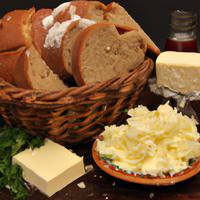
1 serving (100 grams) contains 350 calories, 10.0 grams of protein, 20.0 grams of fat, and 30.0 grams of carbohydrates.

Log this food in SnapCalorie

Nutrition Information
Calories |
833.3 | ||
|---|---|---|---|
% Daily Value* |
|||
| Total Fat | 47.6 g | 61% | |
| Saturated Fat | 28.6 g | 143% | |
| Polyunsaturated Fat | 0 g | ||
| Cholesterol | 119.0 mg | 39% | |
| Sodium | 1190.5 mg | 51% | |
| Total Carbohydrates | 71.4 g | 25% | |
| Dietary Fiber | 4.8 g | 17% | |
| Sugars | 4.8 g | ||
| protein | 23.8 g | 47% | |
| Vitamin D | 119.0 mcg | 595% | |
| Calcium | 357.1 mg | 27% | |
| Iron | 3.6 mg | 20% | |
| Potassium | 238.1 mg | 5% | |
* Percent Daily Values are based on a 2,000 calorie diet. Your daily values may be higher or lower depending on your calorie needs.
Food Attributes
Source of Calories
About Bread with cheese and butter
Bread with cheese and butter is a simple yet satisfying dish found across various cuisines, often served as a snack or breakfast item. It typically includes a slice of bread, slathered with butter, and topped with melted or sliced cheese, combining creamy richness with hearty texture. The origins of this pairing can be traced to European traditions, where bread, cheese, and butter are staple ingredients. Nutritionally, the dish provides carbohydrates from the bread, fats from the butter, and protein and calcium from the cheese. However, moderation is key, as the combination can be high in saturated fats and calories depending on the types of cheese and butter used. Opting for whole-grain bread, low-fat cheese, or plant-based spreads can make it a healthier choice. This easy-to-make dish remains a versatile comfort food, enjoyed warm or cold, alone or paired with soups and salads.



